Pavestone Brochure 2018
Ooh! Here’s a treat! We’ve not had a Pavestone brochure up for review previously. Not sure why that is, as there are copies of every Pavestone brochure going back to 2005 in my library, but they’ve never been submitted for critical assessment until now. And that’s a pity because, over the past decade and more, Pavestone have consistently been one of the more innovative and forward thinking hard-landscaping manufacturers and suppliers, always seeming to lead rather than be led.
Normally, with these brochure reviews, the focus is always on new products, but with this being Pavestone’s debut, everything is, so to speak, new. Consequently, this presents a problem: there isn’t the space or the time to consider and pass comment on the hundreds of products in the rather impressive Pavestone smorgasbord for 2018, so perhaps it’s best to look at the range as a whole, consider the extent, contrast with what other suppliers put out, and pick out one or two eye-catchers. How’s that for a plan?
It makes sense to start with a consideration of the brochure itself. It’s an A4, full-colour, short-spine-bound landscape format, as preferred by most of the discerning suppliers nowadays, with a stiff-ish lightweight card cover, and a sumptuous 128 pages, excluding that seductive satin-touch cover and rear. The main image is a timber-effect linear porcelain (which turns up again on page 4, revealing itself to be Crosswood Buff), with a crisp white header band bearing the simple and elegant Pavestone logo top right and the seemingly mandatory ‘Mission Statement’ – Design For Living – top left.
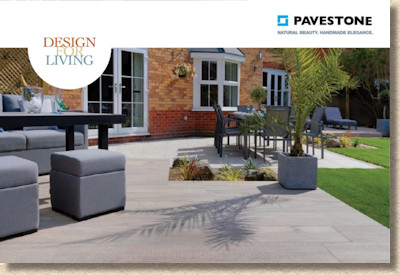
Moving inside and there’s a useful index page. With too many other suppliers, the groupings chosen for the various products ranges can tempt them into realms of fancy, but Pavestone have kept it simple, by organizing according to logical categories, so there’s Porcelain, Natural Stone, Decorative Concrete, Block Paving and Walling. The last few pages are given over to what they refer to as ‘The Detail’, which includes an exemplary selection of installation accessories, along with the essential size and packaging information.
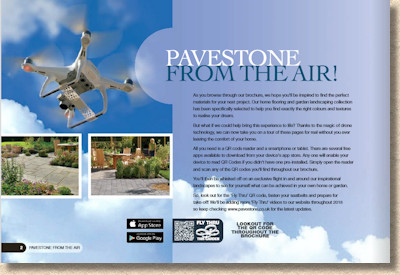
One radical new idea, and one that other suppliers must be kicking themselves for not latching on to, is the QR links to drone-filmed video footage of many of the show-standard installations used to provide the impressive photography. Such a great idea, and like all great ideas, so bleeding simple and obvious. This is, probably, the best use of so-called new technology since the widespread uptake of social media.
On to the meat: like so many other clued-up suppliers in 2018, Pavestone lead off with the current big thing: Porcelain. The selection is comprehensive, with all the usual requirements: a timber-y range; a posh stone-y range; a lightly-patterned stone-y range; a textured stone-y range; and a ‘budget’ range.
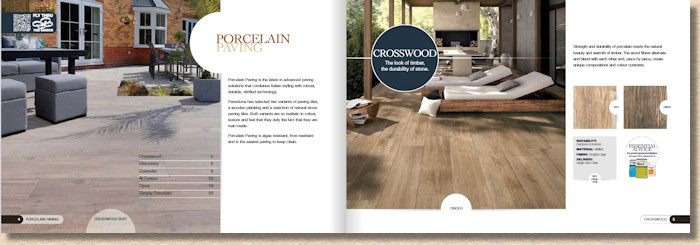
What does set the Pavestone offering apart is the scope of sizes available, but this isn’t made clear on the product pages – you have to check the Technical Spec at the back of the brochure to find out that information. Why? If you’re offering a 1200x600 option, state that on the page with the money-shot photie. Don’t be requiring potential customers to flick through, trying to find page hundred-and-summat. A simple size statement would be so effective.
Maybe the laudable use of full-page, seriously well-staged photies prompted a decision not to clutter the imagery with superfluous text, but then, each range has a small swatch display, with basic info regarding suitability and finish, so why not add sizes?
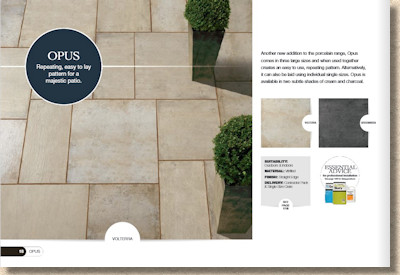
Overall, it’s a cerebral selection of ceramics. Everything you’d expect, with no gimmicks, but something to suit more-or-less every porcelain taste. There’s no indication of origin, which can often be a reliable guide to quality, but the feedback that comes in from contractors is that it’s all very good and sensibly priced.
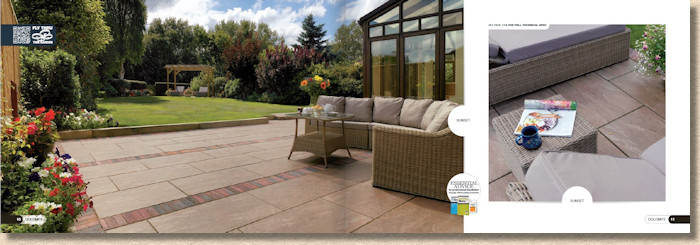
What was previously Pavestone’s forte, Natural Stone, comes next, and as should be expected from a supplier with such a heritage, it’s all pretty much as it should be. It’s all in there: the sandstones and limestones, granites and slates, riven, sawn, and antiqued, plus steps, setts, pavers and circles. Anything missing?
Well, once again, size information! Fantastic photography, lovely products, but what bloody sizes are they?
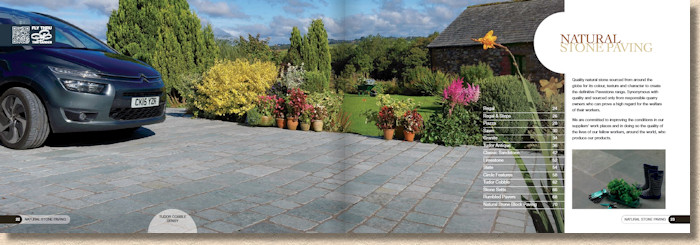
One thing that is really noticeable with the Pavestone photies, and which I can’t recall noticing anywhere else, is the subtle use of contrastingly coloured jointing. No matter what the paving might be, the jointing always contrasts in a way that emphasizes the stone, while rendering itself innocuous.
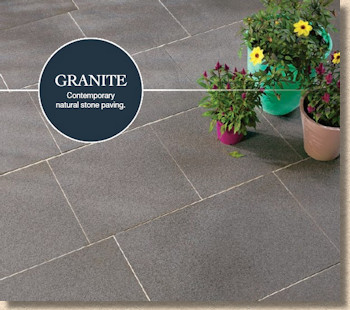
This may be connected to the fact that Pavestone offer an in-house range of two-part resin mortars available in a generous five shades, so, in theory, there is always an optimal colour choice – an option far too many installers blithely overlook. Plain beige resin mortar or pinky-orangey cement mortar does not always show off a paving to best effect. I know it will all look mucky-brown in three months’ time, but for that sought-after beaming smile from the client at handover, the correct choice of jointing can make such a huge difference.
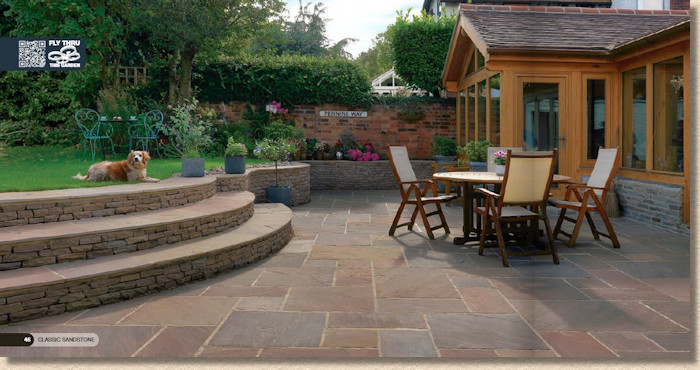
One item always sure to get my back up is the misnaming of setts and cobbles . I know Pavestone aren’t the only guilty party, but given that I’ve found little else to whinge about and we’re halfway through the brochure, it warrants a mention….again. Pieces of stone, worked on all faces, to present a six-sided ‘block’ are NOT cobbles. They are setts. I’ll accepts pavers, paviors, or even tiles, but one thing they most definitely are not is cobbles. Cobbles are UNWORKED or barely worked ‘as found’ stones, usually rounded and shaped like large pebbles or small boulders. It doesn’t matter what term the public use, or what they say on Coronation Street: they are not cobbles. They are setts.
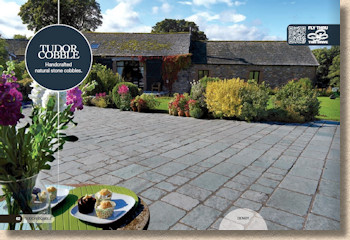
As if to underline the point, the ‘square-cut pieces of stone with dimensions not exceeding 300mm’ shown on page 62 are labelled as Tudor Cobbles, yet on page 67, the ‘square-cut pieces of stone with dimensions not exceeding 300mm’ are suddenly Stone Setts.
Whoa! Page 68. ‘Square-cut pieces of stone with dimensions not exceeding 300mm’ are now Rumbled Pavers! Rumbled pavers laid to a curve with ridiculously ugly gaping joints, but Rumbled Pavers, nonetheless. Oh! The infinite richness of the English language.
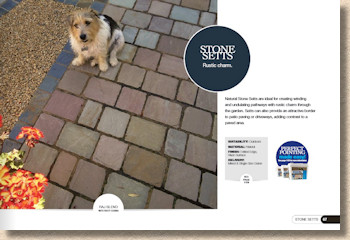
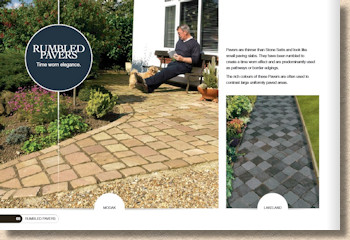
Natural Stone Block Paving logically follows on from Natural Stone, and it’s a group that probably doesn’t get as much attention as it deserves.
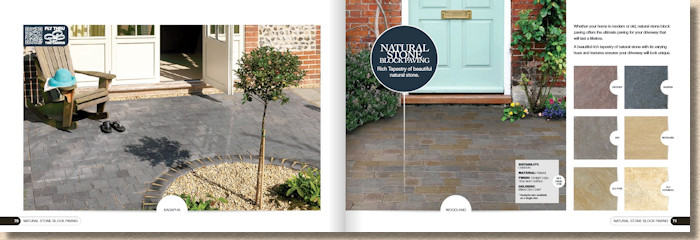
I’ve looked at dozens, probably hundreds of driveways laid with Natural Stone Block Paving (NSBP) from various manufacturers and what always strikes me is that, of the flexibly laid installations , roughly half of them are unnecessarily uneven, like the photies on pages 72/73. This all boils down to the fact that most NSBP is not of a regular thickness. It isn’t calibrated, and so, when it’s laid on a screeded bed, some sit proud and some sit low.
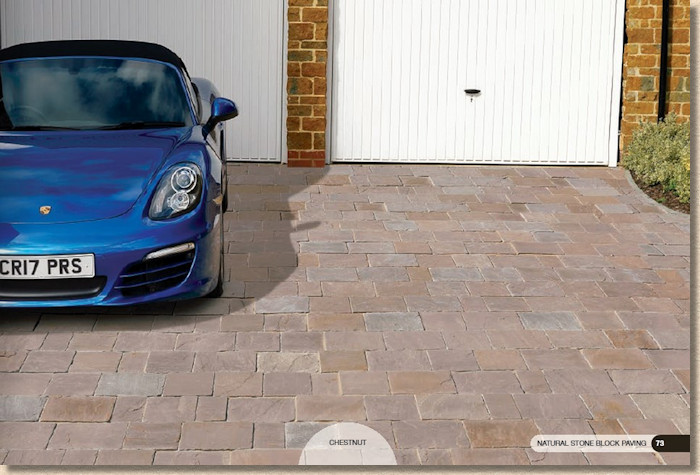
Oh yes, the vibrating plate compactor tends to even this out initially, but this results in some pavers being hammered solid into the bed, while others are skimmed over, bridged by adjacent proud pavers, and barely compacted at all. Give it a couple of months, and once it’s all settled down, the discrepancies make themselves evident once more.
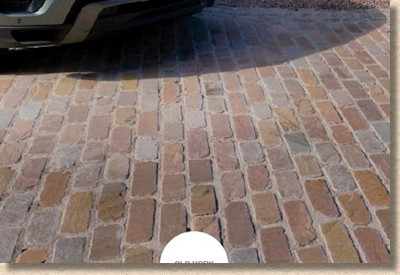
Now, some customers are happy enough with this effect, but there are plenty that will grumble and expect a re-lay. If the customer is made aware of this potential issue beforehand, they can decide whether or not it’s for them. Maybe a rigid-laid NSBP (laid onto a mortar bed) is more to their liking. Sure, it costs more, considerably more, but at least they should be given the choice: accept the unevenness of flexible laying, pay more for calibrated pavers and lose most of the unevenness, or pay a lot more for mortar-bedded pavers that will guarantee a perfect finish.
On to Decorative Concrete Paving, which, with recent developments in concrete technology, is something of a mish-mash of styles. At one end, we have the ultra-modern ‘printed’ surface of what Pavestone refer to as a ‘Hybrid Concrete’, where the colour, texture and pattern exist only as a surface layer of a millimetre or two of high-quality micro-concrete over a base of backing concrete, while at the other end, the avowed rustic charm and warmth of wet-cast reproduction age-old stone flags.
The Hybrid or Engineered concretes have appeared more and more often over recent years. They allow for fantastic stylings, and eye-catching patterns such as the Mosaic on page 78. They also create ultra-dense surfaces that are lower maintenance, and/or more intensely coloured, and/or more intriguingly textured. It’s not quite as resilient as porcelain, but it’s not far off….for the first few years, at least.
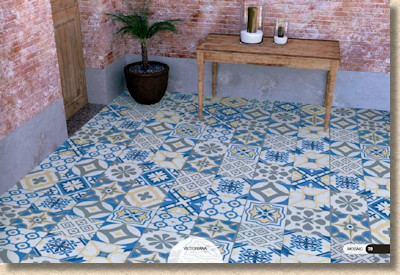
Pavestone have also taken up the M-Coat surface protection that certain other well-known suppliers have dabbled with over the years. Developed, and widely used, in The Netherlands, it has never really caught on in Britain, which is mystifying. It has a lot to offer, not least in minimising maintenance and keeping paving looking tip-top for longer, but maybe it prices itself out of contention?
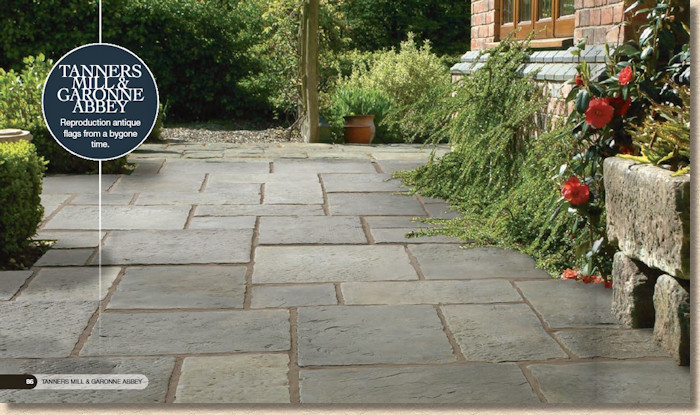
Like the M-Coat, Pavestone’s Concrete Block Paving (CBP) also hail from the Low Countries (do we still call them that?) and they’ve been a reliable earner for the company for many a year. There isn’t the range that you’d get from a full-scale British/Irish manufacturer of CBPs, but then, many of the CBPs made in Europe are really not to our taste. We certainly have no appetite for shaped blocks, and the bog-standard chamfered-edge 200x100 block that powers the British market is, unsurprisingly, not a big seller on the continent.
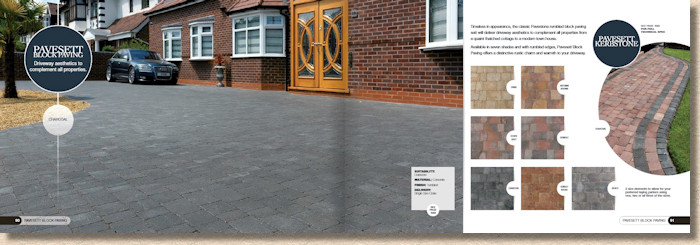
So, Pavestone stick to what we have in common: a liking for tumbled rectangles. Nice, simple squares or oblongs that have been ‘distressed’ to give them a worn and antique-y look, in multi-colours that will empathise with most buildings.
There hasn’t really been much innovation with CBPs for a decade or so, or so it seems from a British/Irish perspective. Slightly different in Europe and North America, admittedly. While we’ve stuck steadfastly to our rectangles, tumbled and untumbled, things have been moving along nicely on the other side of the channel, but the conservative market over here as taken no chances.
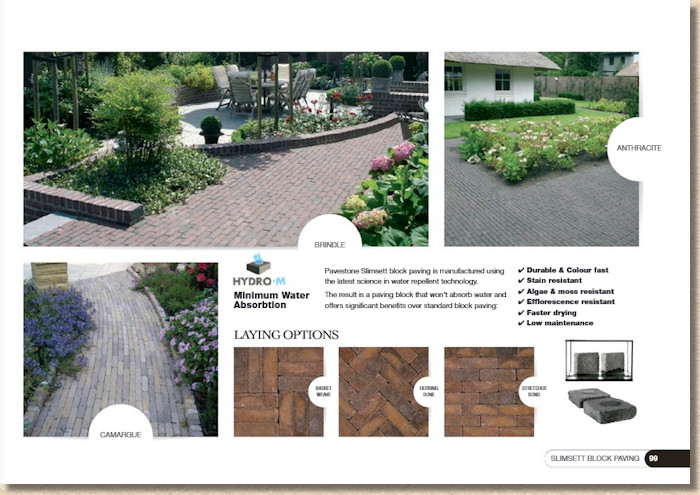
So, it’s good to see a company such as Pavestone pushing innovation just a smidgen with the Hydro-M pavers with their water-repellent (ish) concrete. Why make concrete water-repellent (ish)? It helps with cleanliness, most of all. Blocks stay cleaner for much, much longer; algae and lichens find it much, much harder to get a foothold; and they are more resistant to liquid stains. There’s other benefits, such as lower efflorescence and less colour fade, but it will all come down to price. How much extra will the canny British buyer pay for what has become, unfortunately, a lower-cost paving and surfacing option?
Walling is the last of the product ranges, and, once again, there’s the full gamut of options from Pavestone: Natural Stone, concrete and engineered/hybrid concrete, modern, traditional, conservative, contemporary, brick, block and cladding: it’s all there, and then some!
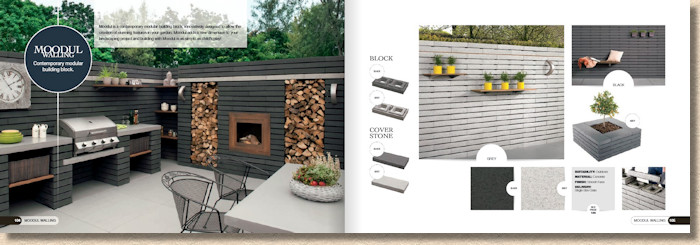
The Moodul modular system deserves a mention, as there’s nothing else quite like it. Yes: of course it’s European! How could anything so cool and chic and understated be anything other than European? But it’s a damned clever system, uncannily similar to the Mega-Blocks used by my toddler grandson. No tiny fiddly studs to link together courses for him: great big ‘tabs’ that interlock with ease yet present a smooth and appealing wall face. It’s a cute and simple alternative to cladding.
There is so much to admire in the Pavestone 2018 brochure. Every aspect of it is well delivered. The design is clean and crisp and uncomplicated. The product selections are comprehensive and excellently considered. The support products (the sealants, jointing, cleaners, etc.) are perfectly judged, and, it seems, have a good reputation with users. The photography is nothing short of superb.
The Technical Info, with that all-important sizes information, has been hived off to the back, but its presentation is spot on. Lovely 3D swatches, clear and concise pack details, explicit coverage statements and no dodgy small print.
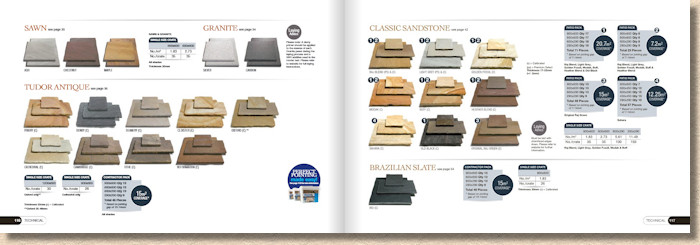
Overall, it’s been an absolute pleasure to leaf through the Pavestone 2018 brochure. There’s everything there should be in a good garden and driveway paving brochure. There’s all the ‘regulars’ you’d expect, plenty of good support items, and enough that’s unique or sufficiently distinctive to keep your attention.
The drone-filmed fly-throughs are a massive advance in how paving can be made to appeal to the public and give them a whole new perspective. Watch how many other suppliers have ‘something similar’ this time next year, if not sooner!
It’s well designed, well laid out, simple to follow, and a real boon to anyone looking to buy, sell or install paving in the coming season.
I can only hope that I’ll be asked back for the 2019 edition!
Pavestone's Customer Helpline: 01386 848 650
Brochure Download: Click Here

